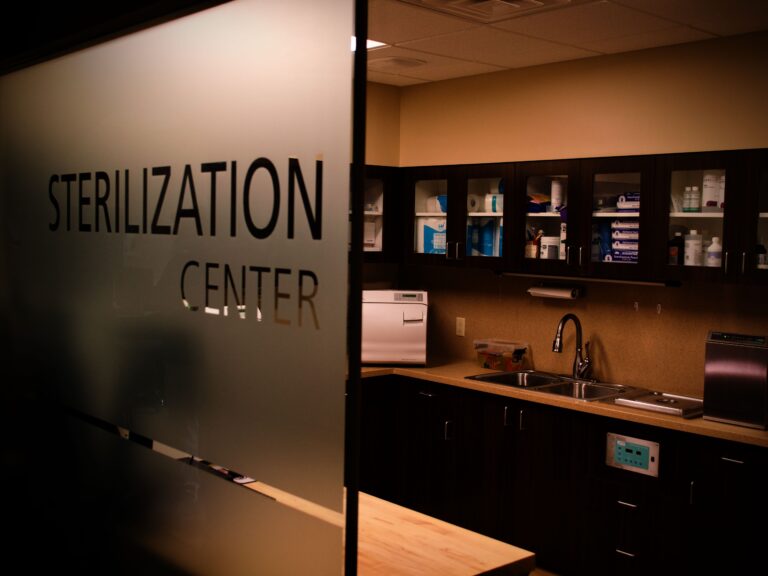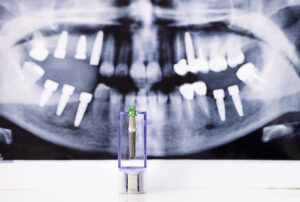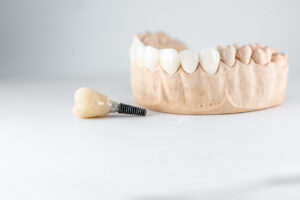What Is Dental Bone Grafting and How Does It Work?
Dental bone grafting is a surgical procedure that replaces or augments lost bone to support dental implants. A graft material—autogenous (from the patient), allogeneic (donor), xenogeneic (animal), or synthetic—is placed in the deficient area to act as a scaffold for new bone growth. This process, known as osseointegration, is vital in the maxilla and mandible, especially where bone resorption from tooth loss, periodontal disease, or trauma has weakened the jaw.
The success of grafting depends on the patient’s systemic health, the type and volume of the graft, and the surgical technique. For instance, autogenous grafts from intraoral sites tend to integrate well due to biological compatibility, and the use of biologically active molecules like platelet-rich plasma (PRP) may enhance healing. Advanced imaging techniques such as CBCT scans also help in accurately diagnosing bone loss and planning the procedure. Overall, bone grafting not only provides mechanical support but also preserves facial aesthetics by maintaining proper jaw contours.
What Are the Different Types of Bone Grafts for Dental Implants?
Dental practitioners use various types of bone grafts to meet clinical needs: – Autogenous grafts: Considered the gold standard for their high success and osteogenic potential, though requiring a secondary surgical site. – Allogeneic grafts: Donor bone processed to remove immunogenic factors, offering a safe alternative. – Xenogeneic grafts: Materials derived from animals, such as bovine bone, which have a similar structure to human bone. – Synthetic grafts: Bioactive ceramics or polymers that mimic natural bone mineral composition.
Each type has pros and cons. Autogenous grafts provide excellent integration but increase patient morbidity, while allogeneic and xenogeneic options simplify surgery despite a theoretical risk of disease transmission. Synthetic options offer controlled composition but may need supplemental therapies for optimal bone growth.
How Does Bone Grafting Support Successful Dental Implant Placement?
Bone grafting enhances the structural integrity of the jaw by increasing bone volume and quality. A stable graft provides the necessary support to anchor dental implants securely, allowing for close contact between the titanium implant and living bone tissue. This intimate contact is critical; any gap increases the risk of implant failure. By supplying a scaffold rich in growth factors and osteogenic cells, the graft helps distribute masticatory forces evenly and preserves the ridge contour, which is vital for both function and aesthetics.
Guided surgery and advanced imaging ensure proper monitoring of graft integration, with research indicating lower rates of early implant mobility and complications like peri-implantitis when grafting is performed as needed.
What Are Common Bone Grafting Procedures Like Sinus Lifts and Ridge Augmentation?
Two common procedures addressing different jaw deficiencies are: – Sinus Lift: Performed in the posterior maxilla where the sinus may have expanded into areas of lost bone. The Schneiderian membrane is carefully elevated, and graft material is inserted into the sinus floor to increase vertical height. – Ridge Augmentation: Aims to improve horizontal or vertical dimensions of the alveolar ridge in both the maxilla and mandible. Techniques may include the use of block or particulate grafts along with barrier membranes to control soft tissue invasion.
Both techniques require precise placement of graft material and stabilization measures. Healing times can vary from 4 to 9 months, but successful procedures result in improved ridge dimensions, better implant stability, and aesthetic prosthetic outcomes.
When Do You Need a Bone Graft Before Getting Dental Implants?
The decision to perform bone grafting is based on a comprehensive evaluation involving both radiographic imaging and clinical assessment. Bone loss from periodontal disease, extended edentulism, trauma, or congenital issues can render the existing bone insufficient for securely holding an implant.
How Is Bone Loss Diagnosed Before Implant Surgery?
Advanced imaging such as Cone Beam Computed Tomography (CBCT) provides three-dimensional views of the jaw, allowing dental professionals to measure bone height, width, and density precisely. Complementary clinical examinations and bone probing tests help determine whether the patient meets the standards necessary for stable implant fixation. If the bone volume is below the required threshold, grafting is recommended to avoid surgical complications and ensure a favorable long-term outcome.
What Are the Signs That Indicate a Bone Graft Is Necessary?
Key indicators for needing a bone graft include: – Noticeably narrow ridge or reduced bone height on radiographs. – History of periodontal disease or long-term tooth loss. – Difficulty achieving primary stability during implant planning. – Subtle clinical signs such as increased tooth mobility or irregular ridge contour.
These signs suggest that the available bone might be insufficient to support an implant, warranting augmentation to improve both function and aesthetics.
Can Bone Grafting Be Avoided in Some Implant Cases?
In instances of minimal bone loss, some advanced implant designs, such as short or narrow implants, may provide adequate stability without grafting. However, these options are generally limited to cases with very mild deficiencies. In most patients, especially those with significant bone loss, grafting remains the gold standard to optimize implant success and longevity.
Why Is Bone Grafting Important for Dental Implant Success?
Bone grafting is critical to ensure dental implant stability and long-term success. By restoring lost bone, grafting enables the titanium implant to achieve optimal contact with the natural jawbone, fostering robust osseointegration.
How Does Bone Grafting Improve Implant Stability and Osseointegration?
The graft material serves as a scaffold that gradually transitions into vital bone as it heals. This integration not only increases the strength and stability of the implant but also aids in evenly distributing masticatory forces. Using barrier membranes further enhances the process by preventing soft tissue intrusion, thereby supporting unobstructed bone regeneration. As a result, implants placed in grafted sites tend to have success rates comparable to those inserted in native bone.
What Are the Risks of Skipping Bone Grafting When Needed?
Opting out of necessary bone grafting can lead to: – Implant instability. – Peri-implantitis and further bone resorption. – Improper implant angulation and aesthetic issues. – Increased likelihood of soft tissue recession, potentially exposing metal components such as abutments.
These complications not only undermine implant function but may also necessitate additional surgical interventions, increasing treatment time and cost.
How Does Bone Grafting Affect Long-Term Oral Health?
A successful bone graft contributes to the preservation of facial structure and proper occlusion by preventing ongoing bone resorption. As the implant integrates securely with the grafted bone, patients enjoy improved masticatory efficiency, stable prosthetic function, and a lower incidence of complications such as graft or implant failure. In the long run, robust bone health supports overall oral functionality and aesthetics.
What Is the Bone Grafting Procedure Like?
The bone grafting procedure is methodically planned and executed to maximize bone regeneration and support implant placement. It starts with a detailed diagnostic assessment, including radiographs and clinical evaluations, to determine the quality and quantity of existing bone.
How Long Does Bone Grafting Take and What Is the Recovery Time?
Procedures usually last between 60 and 120 minutes, depending on complexity. Initial healing typically requires 4 to 6 months before implant placement, during which patients must maintain strict oral hygiene and follow dietary recommendations. While mild discomfort and swelling are common post-operatively, these symptoms are generally manageable with medications, and most patients resume normal activities within a week.
What Are the Steps Involved in a Typical Bone Grafting Surgery?
A standard bone grafting surgery involves: 1. Administration of local anesthesia or sedation. 2. Incision along the gum line to expose the deficient bone. 3. Shaping and placement of the graft material into the defect. 4. Stabilization of the graft with screws or membranes as needed. 5. Suturing the soft tissue to create a closed, healing environment.
Maintaining a sterile surgical field and using barrier membranes are crucial to preventing infection and ensuring successful bone regeneration.
What Are the Possible Side Effects and How Are They Managed?
Potential side effects include mild swelling, bruising, and minor bleeding or infections. These are usually controlled with antibiotics and proper oral care. In rare cases, issues such as membrane exposure or delayed healing require prompt follow-up with the dental professional to adjust treatment as necessary.
How Do You Know if You Need a Bone Graft: Common Patient Questions Answered
Patients frequently wonder about the need for bone grafting before dental implants. A detailed clinical and radiographic assessment helps determine whether the available bone is sufficient.
Do I Need a Bone Graft for My Dental Implants?
The decision is made on a case-by-case basis. Diagnostic imaging and clinical evaluations assess bone volume and density, and if these fall below the required standards, a bone graft is recommended to ensure implant stability.
How Much Does Bone Grafting Cost and Is It Covered by Insurance?
Costs vary based on the graft type, defect size, and case complexity. Many dental insurance plans may partially cover the procedure if it is deemed medically necessary.
How Can I Prepare for Bone Grafting Surgery?
Proper preparation includes a comprehensive dental examination, imaging studies to assess bone loss, and adherence to pre-operative instructions regarding medications, diet, and oral hygiene. Discussing any health issues with your surgeon is also important to optimize healing.
What Are the Latest Advances in Bone Grafting Materials and Techniques?
Recent innovations have improved outcomes and reduced recovery times for bone grafting. These include synthetic graft materials that closely mimic natural bone and promote faster integration through enhanced vascularization and cell migration.
How Do Advanced Bone Grafting Materials Improve Outcomes?
Materials such as recombinant human bone morphogenetic proteins (rhBMPs) and bioactive glass not only provide a structural scaffold but also actively stimulate bone formation. This results in more predictable regeneration and faster healing.
What Personalized Treatment Plans Are Available for Bone Grafting?
Modern dental practices use 3D imaging and digital planning to create personalized graft designs tailored to each patient’s unique bone deficiencies. This approach enhances graft integration and ensures long-term implant durability by considering factors like age, systemic health, and lifestyle.
How Does Apex Dental Use Advanced Techniques for Bone Grafting?
Apex Dental employs computer-guided planning and minimally invasive techniques to deliver precise graft placement and superior outcomes. Their approach ensures faster recovery and establishes a strong, aesthetically pleasing implant foundation.
What Are the Alternatives to Bone Grafting Before Dental Implants?
Although bone grafting is the standard solution for insufficient jawbone, alternatives exist in certain cases: – Short or Narrow Implants: Developed to fit into areas with minimal bone, these implants may eliminate the need for grafting in select cases. – Bone Growth Stimulators and Biologic Agents: These non-invasive methods can enhance the natural regenerative capacity of the bone but are typically most effective when used in conjunction with other treatments. – Delayed Implant Placement: In complex cases or when systemic health issues are present, delaying implant placement may allow for natural bone stabilization without immediate grafting.
Each alternative should be considered based on a thorough diagnostic evaluation and in consultation with a dental professional.
Final Thoughts
Dental bone grafting is fundamental to the success of dental implants. By restoring lost bone, the procedure reinforces implant stability, supports osseointegration, and improves both aesthetics and functionality. Advances in grafting techniques and materials continue to enhance predictability and patient outcomes, ensuring that implants not only perform well but also contribute to long-term oral health.








